Prophylactic Anti-Osteoporotic Effect of Matricaria chamomilla L. Flower Using Steroid-Induced Osteoporosis in Rat Model and Molecular Modelling Approaches
Abstract
:1. Introduction
2. Materials and Methods
2.1. Plant Material
2.2. Preparation of the Plant Extract
2.3. In Vivo Anti-Osteoporotic Activity Evaluation
2.3.1. Animals and Animal Treatment
2.3.2. Experimental Protocol
2.3.3. Evaluation of the Biochemical Parameters
2.3.4. Evaluation of the Biomechanical Parameters
Determination of Bone Hardness
Determination of Length, Weight, and Thickness of Femur
Histopathological Examination
2.3.5. Statistical Analysis
2.4. In Silico Molecular Modeling Studies
2.4.1. Molecular Docking
2.4.2. ADME/TOPKAT In Silico Evaluation
3. Results
3.1. In Vivo Anti-Osteoporotic Activity Evaluation
3.1.1. Determination of the Biochemical Parameters
Effect of Matricaria chamomilla on Serum Calcium Level in Steroid Induced Osteoporotic Rat Model
Effect of Matricaria chamomilla on Serum Phosphate Level in Steroid Induced Osteoporotic Rat Model
Effect of Matricaria chamomilla on Serum Magnesium Level in Steroid Induced Osteoporotic Rat Model
Effect of Matricaria chamomilla on Serum Creatinine Level in Steroid Induced Osteoporotic Rat Model
Effect of Matricaria chamomilla on Serum Alkaline Phosphatase Level in Steroid-Induced Osteoporotic Rat Model
3.1.2. Determination of the Biomechanical Parameters
3.1.3. Histopathological Examination
3.2. Functional Phenolic Substances Predominating in Matricaria chamomilla Flowers
3.3. In Silico Molecular Modeling Studies
3.3.1. Molecular Docking
3.3.2. ADME/TOPKAT In Silico Evaluation
4. Discussion
5. Conclusions
Author Contributions
Funding
Institutional Review Board Statement
Informed Consent Statement
Data Availability Statement
Acknowledgments
Conflicts of Interest
References
- Kasturi, G.C.; Cifu, D.X.; Adler, R.A. A review of osteoporosis: Part I. Impact, pathophysiology, diagnosis and unique role of the physiatrist. PM&R 2009, 1, 254–260. [Google Scholar]
- Wu, A.-M.; Chi, Y.-L.; Ni, W.-F. Vertebral compression fracture with intravertebral vacuum cleft sign: Pathogenesis, image, and surgical intervention. Asian Spine J. 2013, 7, 148–155. [Google Scholar] [CrossRef] [PubMed] [Green Version]
- Gilman, M.T.A. Goodman Gilman’s The Pharmacological Basis of Therapeutics, 13th ed.; McGraw-hill Education: New York, NY, USA, 2011. [Google Scholar]
- Kanis, J.A.; Pitt, F. Epidemiology of osteoporosis. Bone 1992, 13, S7–S15. [Google Scholar] [CrossRef]
- Fitzpatrick, L.A. Secondary causes of osteoporosis. Mayo Clin. Proc. 2002, 77, 453–468. [Google Scholar] [CrossRef] [Green Version]
- Jung, W.-W. Protective effect of apigenin against oxidative stress-induced damage in osteoblastic cells. Int. J. Mol. Med. 2014, 33, 1327–1334. [Google Scholar] [CrossRef] [Green Version]
- Diemar, S.S.; Sejling, A.-S.; Eiken, P.; Andersen, N.B.; Jørgensen, N.R. An explorative literature review of the multifactorial causes of osteoporosis in epilepsy. Epilepsy Behav. 2019, 100, 106511. [Google Scholar] [CrossRef]
- Mauck, K.F.; Clarke, B.L. Diagnosis, screening, prevention, and treatment of osteoporosis. Mayo Clin. Proc. 2006, 81, 662–672. [Google Scholar] [CrossRef] [PubMed] [Green Version]
- Cosman, F.; Nieves, J.W.; Dempster, D.W. Treatment sequence matters: Anabolic and antiresorptive therapy for osteoporosis. J. Bone Min. Res. 2017, 32, 198–202. [Google Scholar] [CrossRef] [Green Version]
- Veldurthy, V.; Wei, R.; Oz, L.; Dhawan, P.; Jeon, Y.H.; Christakos, S. Vitamin D, calcium homeostasis and aging. Bone Res. 2016, 4, 1–7. [Google Scholar] [CrossRef] [Green Version]
- Youssef, F.S.; Eid, S.Y.; Alshammari, E.; Ashour, M.L.; Wink, M.; El-Readi, M.Z. Chrysanthemum indicum and Chrysanthemum morifolium: Chemical composition of their essential oils and their potential use as natural preservatives with antimicrobial and antioxidant activities. Foods 2020, 9, 1460. [Google Scholar] [CrossRef]
- Orey, C. The Healing Powers of Essential Oils: A Complete Guide to Nature’s Most Magical Medicine; Citadel Press: New York, NY, USA, 2019; Volume 8. [Google Scholar]
- Ross, S.M. Generalized anxiety disorder (GAD): Efficacy of standardized Matricaria recutita (German chamomile) extract in the treatment of generalized anxiety disorder. Holist. Nurs. Pract. 2013, 27, 366–368. [Google Scholar] [CrossRef] [PubMed]
- Murti, K.; Panchal, M.A.; Gajera, V.; Solanki, J. Pharmacological properties of Matricaria recutita: A review. Pharmacologia. 2012, 3, 348–351. [Google Scholar] [CrossRef] [Green Version]
- Mann, C.; Staba, E.J. Herbs, Spices, and Medicinal Plants: Recent Advances in Botany, Horticulture, and Pharmacology; Hawrth Press: New York, NY, USA, 1986; Volume 1, p. 235. [Google Scholar]
- Kim, T.-H.; Jung, J.W.; Ha, B.G.; Hong, J.M.; Park, E.K.; Kim, H.-J.; Kim, S.-Y. The effects of luteolin on osteoclast differentiation, function in vitro and ovariectomy-induced bone loss. J. Nutr. Biochem. 2011, 22, 8–15. [Google Scholar] [CrossRef] [PubMed]
- Shi, X.; Li, C.; Wan, Q.; Li, A.; Wang, H.; Liu, K. Drynaria total flavonoids decrease cathepsin K expression in ovariectomized rats. Genet. Mol. Res. 2014, 13, 4311–4319. [Google Scholar] [CrossRef] [PubMed]
- Karbalaei, D.; Nourafshan, A. Antiulcerogenic effects of Matricaria chamomilla extract in experimental gastric ulcer in mice. Iran. J. Med. Sci. 2009, 34, 198–203. [Google Scholar]
- Chitme, H.; Muchandi, I.; Burli, S. Effect of Asparagus racemosus Willd root extract on ovariectomized rats. Open Nat. Prod. J. 2009, 2, 16–23. [Google Scholar] [CrossRef]
- Salman, S.; Kumbasar, S.; Hacimuftuoglu, A.; Ozturk, B.; Seven, B.; Polat, B.; Gundogdu, C.; Demirci, E.; Yildirim, K.; Akcay, F. The effect of metyrosine/prednisolone combination to oophorectomy-induced osteoporosis. Iran. J. Reprod. Med. 2012, 10, 363–372. [Google Scholar]
- Song, L. Calcium and bone metabolism indices. Adv. Clin. Chem. 2017, 82, 1–46. [Google Scholar]
- Li, C.S.; Deschenes, D.; Desmarais, S.; Falgueyret, J.-P.; Gauthier, J.Y.; Kimmel, D.B.; Léger, S.; Massé, F.; McGrath, M.E.; McKay, D.J. Identification of a potent and selective non-basic cathepsin K inhibitor. Bioorg. Med. Chem. Lett. 2006, 16, 1985–1989. [Google Scholar] [CrossRef]
- Janibekov, A.A.; Youssef, F.S.; Ashour, M.L.; Mamadalieva, N.Z. New flavonoid glycosides from two Astragalus species (Fabaceae) and validation of their antihyperglycaemic activity using molecular modelling and in vitro studies. Ind. Crops Prod. 2018, 118, 142–148. [Google Scholar] [CrossRef]
- Altyar, A.E.; Ashour, M.L.; Youssef, F.S. Premna odorata: Seasonal metabolic variation in the essential oil composition of its leaf and verification of its anti-ageing potential via in vitro assays and molecular modelling. Biomolecules 2020, 10, 879. [Google Scholar] [CrossRef] [PubMed]
- Youssef, F.S.; Ovidi, E.; Musayeib, N.M.A.; Ashour, M.L. Morphology, anatomy and secondary metabolites investigations of Premna odorata Blanco and evaluation of its anti-tuberculosis activity using in vitro and in silico studies. Plants 2021, 10, 1953. [Google Scholar] [CrossRef] [PubMed]
- Gupta, V.; Mittal, P.; Bansal, P.; Khokra, S.L.; Kaushik, D. Pharmacological potential of Matricaria recutita—A review. Int. J. Pharm. Sci. Drug Res. 2010, 2, 12–16. [Google Scholar]
- Exner, J.; Reichling, J.; Becker, H. Flavonoids in Matricaria chamomile. In Planta Medica; Georg Thieme Verlag: Stuttgart, Germany, 1980. [Google Scholar]
- Kunde, R.; Isaac, O. Über die Flavone der Kamille (Matricaria chamomilla L.) und ein neues acetyliertes Apigenin–7–glucoside. Planta Med. 1979, 37, 124–130. [Google Scholar]
- Tyihak, E.; Sarkany-Kiss, J.; Verzar-Petri, G. Phytochemical investigation of apigenin glycosides of Matricaria chamomilla. Pharmazie 1962, 17, 301–304. [Google Scholar]
- Singh, O.; Khanam, Z.; Misra, N.; Srivastava, M.K. Chamomile (Matricaria chamomilla L.). An overview. Pharmacog. Rev. 2011, 5, 82–95. [Google Scholar] [CrossRef] [Green Version]
- Xie, X.-Y.; Chen, F.-F.; Shi, Y.-P. Simultaneous determination of eight flavonoids in the flowers of Matricaria chamomilla by high performance liquid chromatography. J. AOAC Int. 2014, 97, 778–783. [Google Scholar] [CrossRef]
- Sambrook, P. How to prevent steroid induced osteoporosis. Ann. Rheum. Dis. 2005, 64, 176–178. [Google Scholar] [CrossRef] [Green Version]
- Weiss, M.J.; Henthorn, P.S.; Lafferty, M.A.; Slaughter, C.; Raducha, M.; Harris, H. Isolation and characterization of a cDNA encoding a human liver/bone/kidney-type alkaline phosphatase. Proc. Natl. Acad. Sci. USA 1986, 83, 7182–7186. [Google Scholar] [CrossRef] [Green Version]
- Sharma, U.; Pal, D.; Prasad, R. Alkaline phosphatase: An overview. Ind. J. Clin. Biochem. 2014, 29, 269–278. [Google Scholar] [CrossRef] [PubMed] [Green Version]
- Lowe, D.; Sanvictores, T.; John, S. Alkaline phosphatase. In Treasure Island; StatPearls: Treasure Island, FL, USA, 2017. [Google Scholar]
- Bonjour, J.-P. Calcium and phosphate: A duet of ions playing for bone health. J. Am. Coll. Nutri. 2011, 30, 438S–448S. [Google Scholar] [CrossRef] [PubMed]
- Castiglioni, S.; Cazzaniga, A.; Albisetti, W.; Maier, J.A. Magnesium and osteoporosis: Current state of knowledge and future research directions. Nutrients 2013, 5, 3022–3033. [Google Scholar] [CrossRef] [PubMed] [Green Version]
- Huh, J.H.; Choi, S.I.; Lim, J.S.; Chung, C.H.; Shin, J.Y.; Lee, M.Y. Lower serum creatinine is associated with low bone mineral density in subjects without overt nephropathy. PLoS ONE 2015, 10, e0133062. [Google Scholar] [CrossRef] [Green Version]
- Ilias, I.; Zoumakis, E.; Ghayee, H. An overview of glucocorticoid induced osteoporosis. In Endocrinology Book; Feingold, K.R., Anawalt, B., Boyce, A., Eds.; Endotext [Internet] South Dartmouth: Bristol, UK, 2018. Available online: https://www.ncbi.nlm.nih.gov/books/NBK278968/ (accessed on 1 April 2022).
- Domazetovic, V.; Marcucci, G.; Iantomasi, T.; Brandi, M.L.; Vincenzini, M.T. Oxidative stress in bone remodeling: Role of antioxidants. Clin. Cases Min. Bone Metabol. 2017, 14, 209–216. [Google Scholar] [CrossRef] [PubMed]
- Abdollahi, M.; Larijani, B.; Rahimi, R.; Salari, P. Role of oxidative stress in osteoporosis. Clin. Pract. 2005, 2, 787–796. [Google Scholar] [CrossRef]
- Wang, Q.; Huo, X.; Wang, J.; Wang, D.; Zhu, Q.; Liu, B.; Xu, L. Rutin prevents the ovariectomy-induced osteoporosis in rats. Eur. Rev. Med. Pharmacol. Sci. 2017, 21, 1911–1917. [Google Scholar]
- Zhou, X.; Wang, F.; Zhou, R.; Song, X.; Xie, M. Apigenin: A current review on its beneficial biological activities. J. Food Biochem. 2017, 41, e12376. [Google Scholar] [CrossRef]
- Yao, L.; Fan, Z.; Han, S.; Sun, N.; Che, H. Apigenin attenuates the allergic reactions by competitively binding to ER with estradiol. Front. Pharmacol. 2020, 11, 1046. [Google Scholar] [CrossRef]
- Badole, S.; Kotwal, S. Equisetum arvense: Ethanopharmacological and Phytochemical review with reference to osteoporosis. Int. J. Pharm. Sci. Health Care 2014, 1, 131–141. [Google Scholar]
- Brömme, D.; Lecaille, F. Cathepsin K inhibitors for osteoporosis and potential off-target effects. Expert Opin. Investig. Drugs 2009, 18, 585–600. [Google Scholar] [CrossRef] [Green Version]
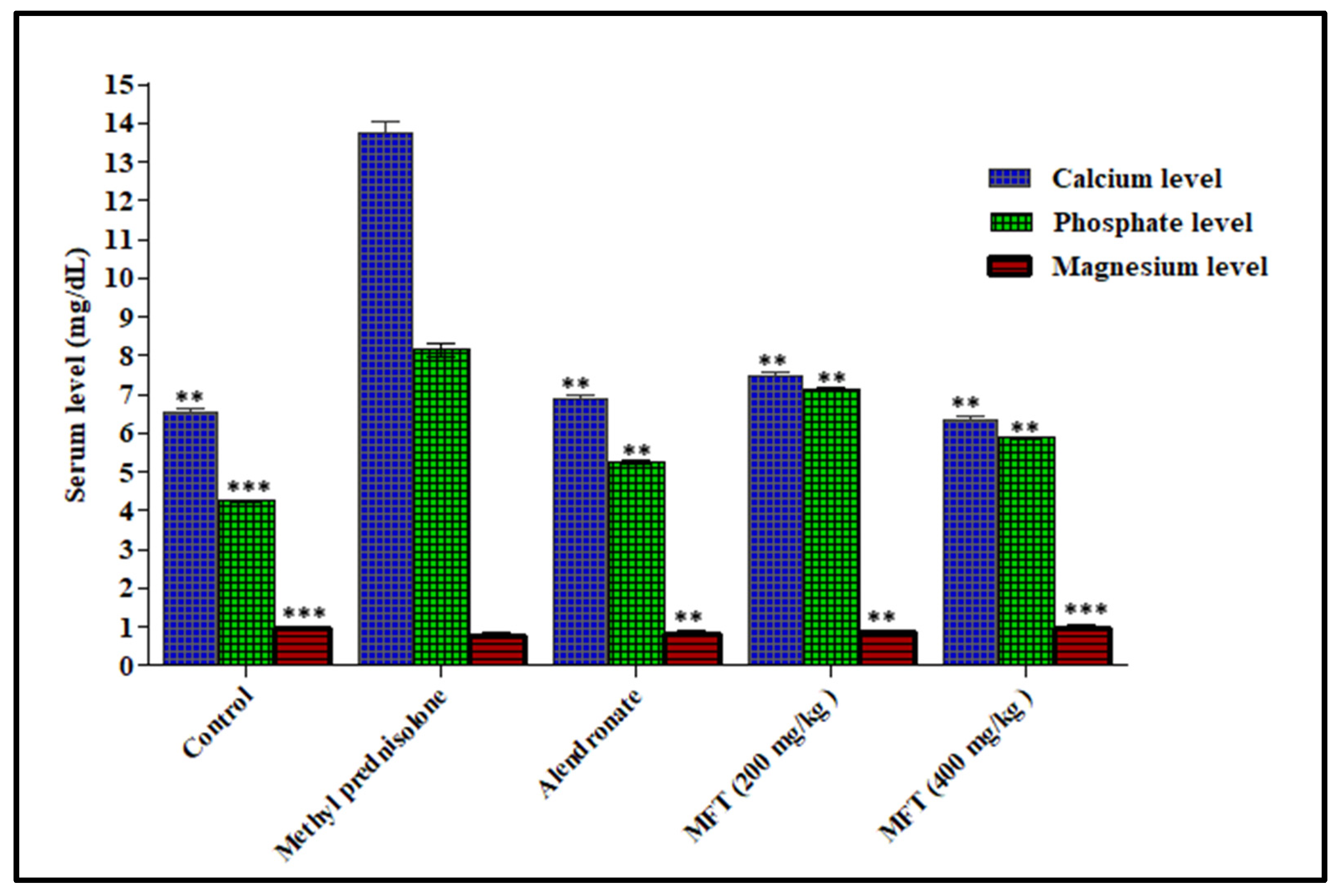
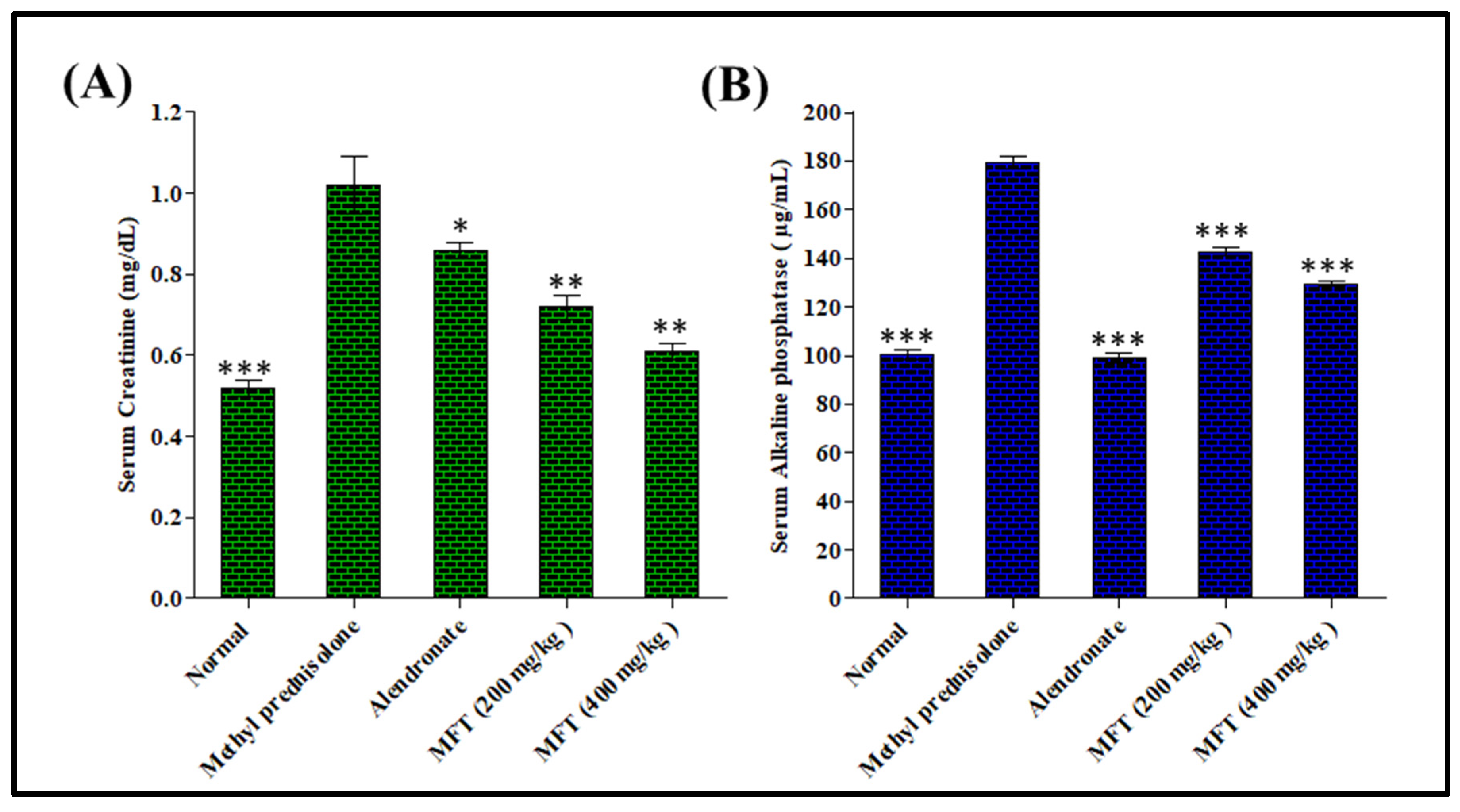
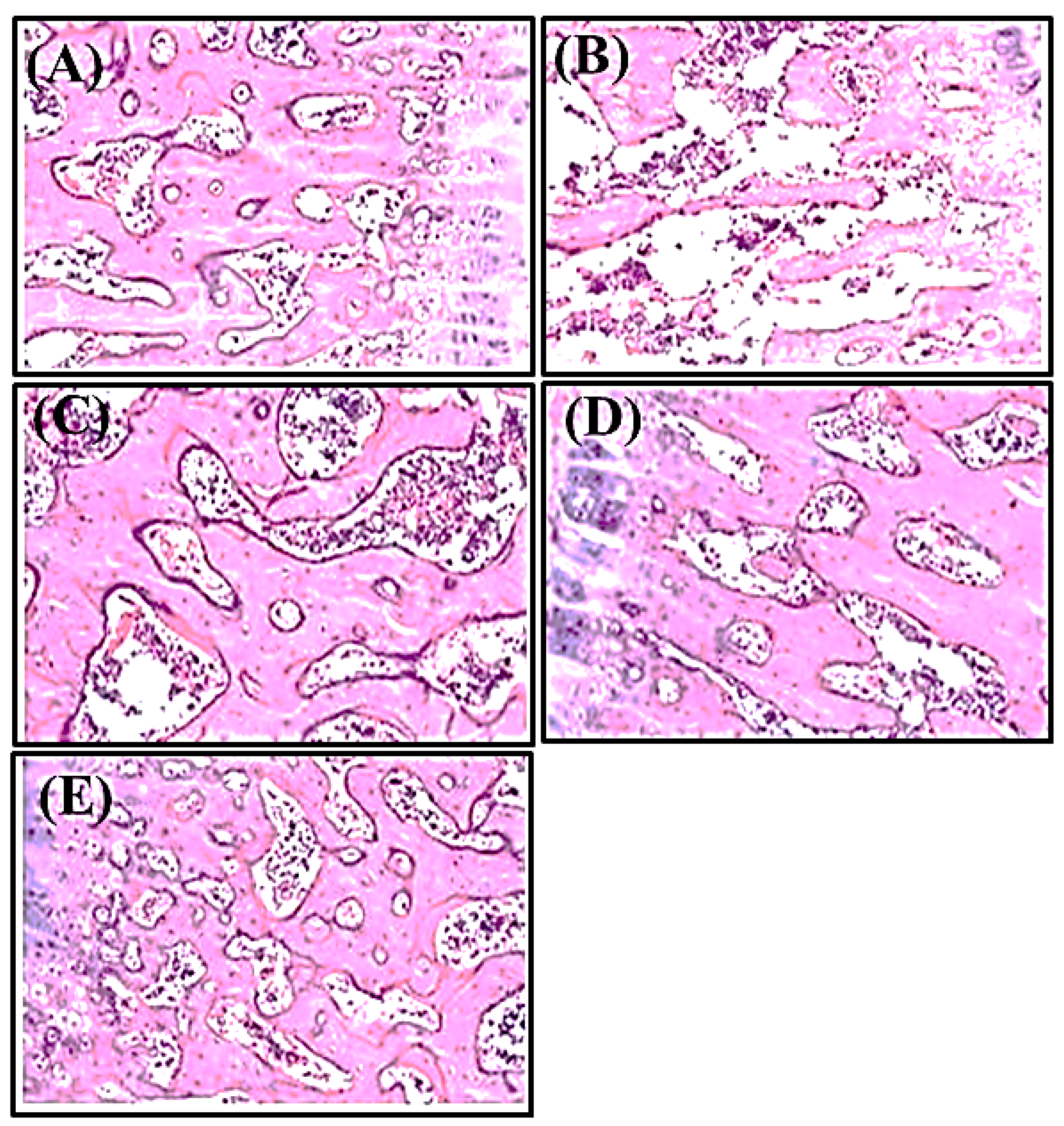
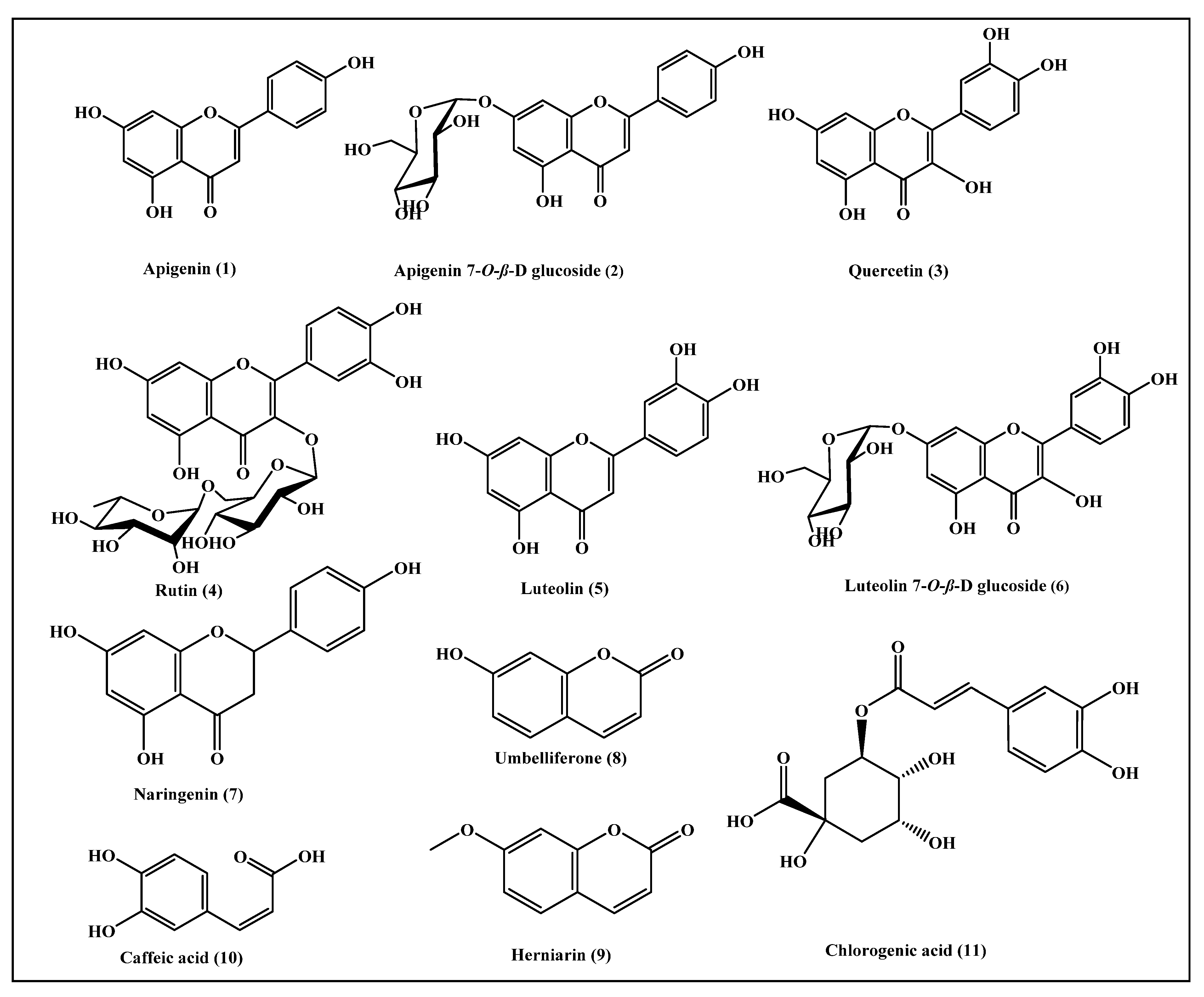
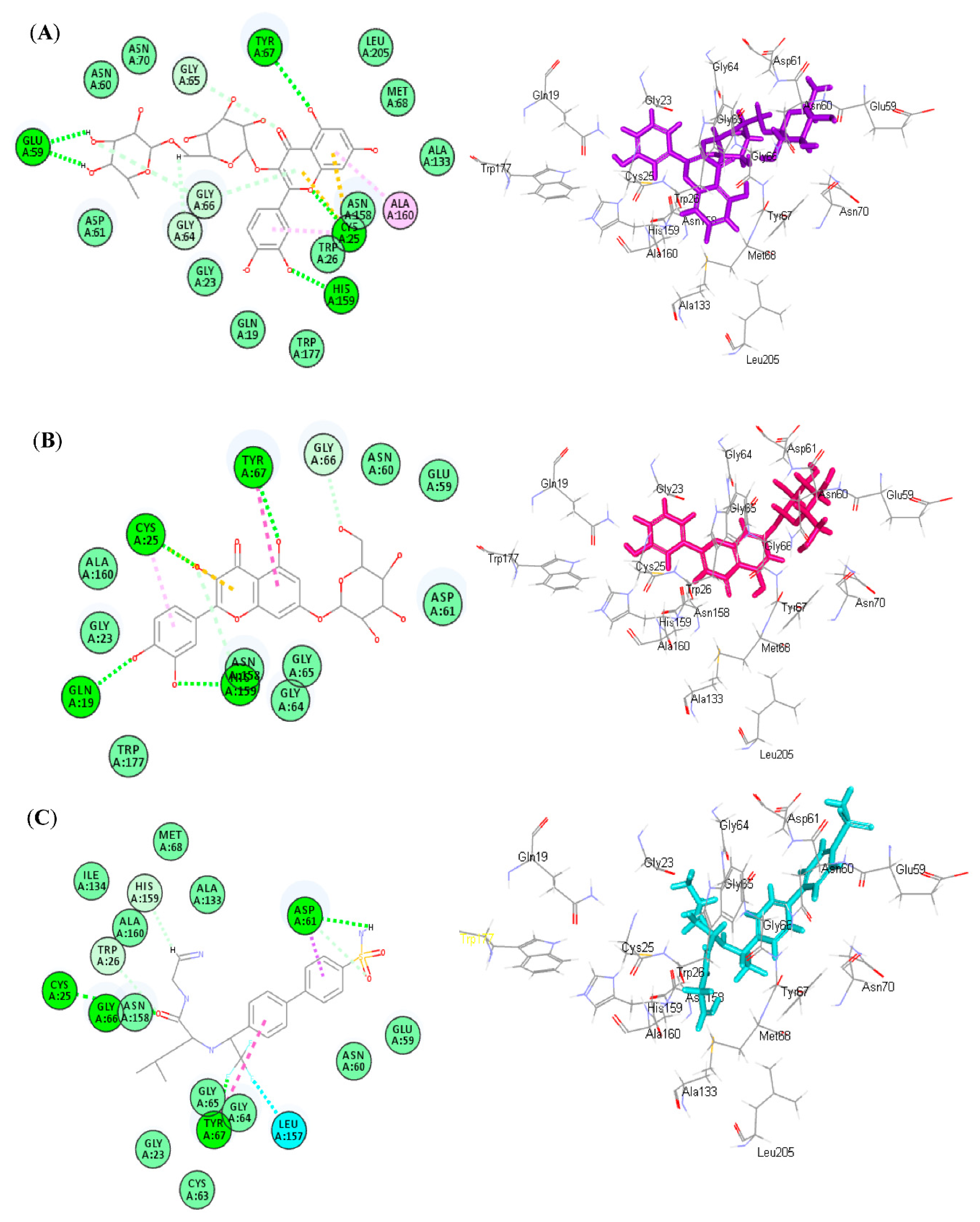
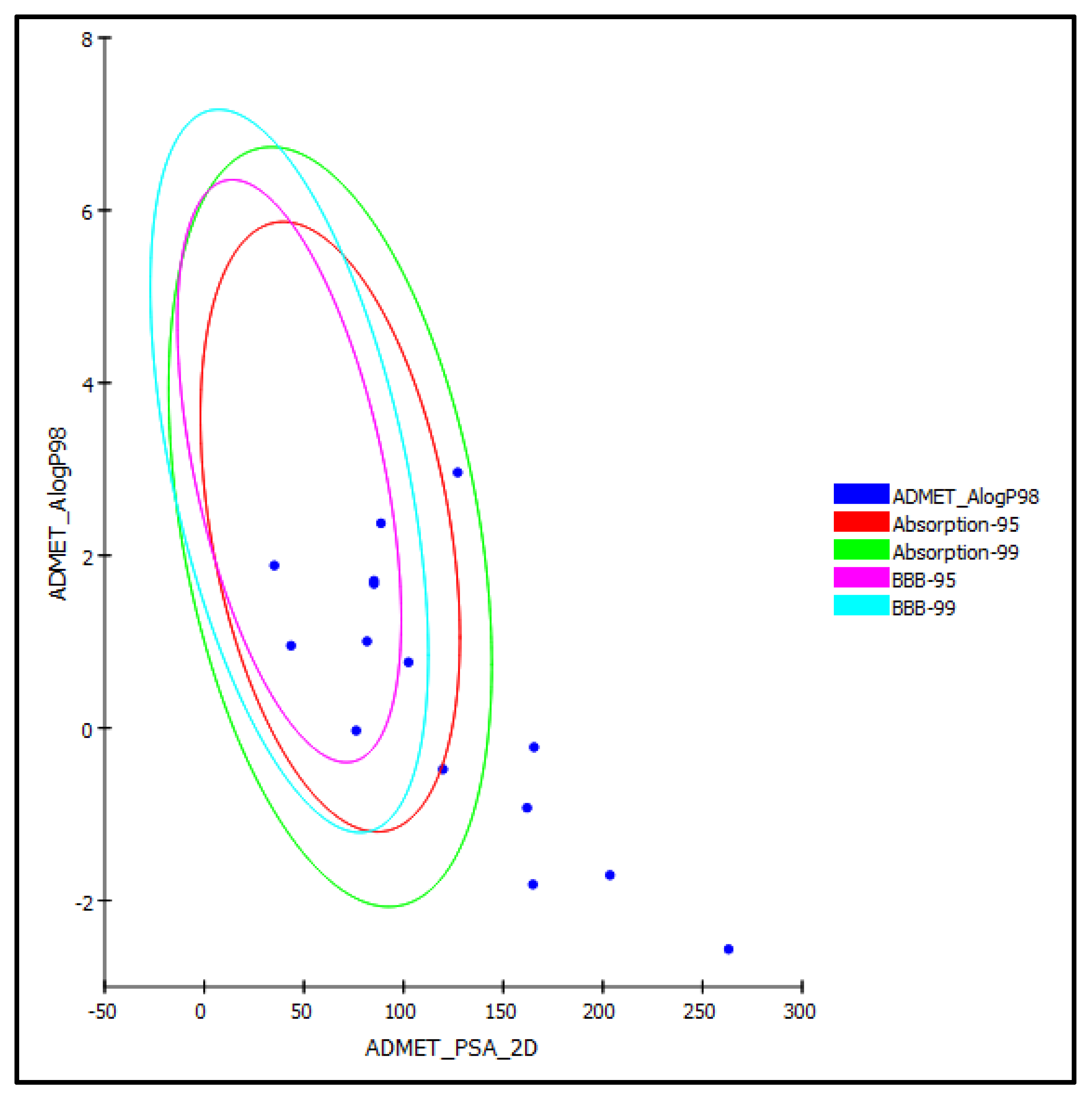
| Group | Bone Breaking Strength (Kg/cm2) | Bone Thickness (mm) | Bone Length (cm) | |
|---|---|---|---|---|
| 1 | Normal control | 4.3 ± 0.14 *** | 5.51 ± 0.14 *** | 3.5 ± 0.08 |
| 2 | Diseased control (Methyl prednisolone) | 3.6 ± 0.23 | 3.30 ± 0.17 | 3.5 ± 0.03 |
| 3 | Standard control (Alendronate) | 3.8 ± 0.03 ** | 4.70 ± 0.12 ** | 3.5 ± 0.04 |
| 4 | MFT (200 mg/kg) | 3.6 ± 0.05 * | 3.9 ± 0.12 * | 3.6 ± 0.05 * |
| 5 | MFT (400 mg/kg) | 4.2 ± 0.27 ** | 4.8 ± 0.18 ** | 3.6 ± 0.06 * |
| Compound | Cathepsin K | Number of Formed Hydrogen Bonds with the Amino Acid Residues |
|---|---|---|
| Apigenin (1) | −32.82 | 2; Gln19 and Tyr67 |
| Apigenin-7-O-β-glucoside (2) | −39.57 | 2; Gln19 and Trp177 |
| Quercetin (3) | −28.64 | 1; Cys25 |
| Rutin (4) | −54.19 | 5; Glu59, Tyr67, Cys25, His159 |
| Luteolin (5) | −28.34 | 2; Gln19 and Gly66 |
| Luteolin-7-O-β-glucoside (6) | −41.91 | 4; Cys25, Tyr67, His159, Gln19 |
| Naringenin (7) | −33.51 | 5; Asp61, Gly66, Cys25, Leu157, Tyr67 |
| Umbelliferone (8) | −22.31 | 3; Gly66, Cys25, Tyr67 |
| Herniarin (9) | −20.70 | 2; Cys25 |
| Caffeic acid (10) | −23.85 | 3; Gly66, Cys25, Gly64 |
| Chlorogenic acid (11) | −36.73 | 3; Gly66 and Asp61 |
| Co-crystalized ligand (NFT) | −67.16 | 3; Cys25, Gly66, Asp61, Tyr67 |
| Compounds | Absorption Level | Solubility Level | BBB Level | PPB Level | CPY2D6 | Hepatotoxic | Alog p98 | PSA-2D |
|---|---|---|---|---|---|---|---|---|
| Apigenin (1) | 0 | 3 | 3 | True | NI | True | 1.00 | 81.65 |
| Apigenin-7-O-β-glucoside (2) | 3 | 4 | 4 | False | NI | True | −0.93 | 161.95 |
| Quercetin (3) | 1 | 4 | 4 | True | NI | True | −0.48 | 119.76 |
| Rutin (4) | 3 | 3 | 4 | False | NI | True | −2.57 | 263.08 |
| Luteolin (5) | 0 | 3 | 3 | True | NI | True | 0.76 | 102.46 |
| Luteolin-7-O-β-glucoside (6) | 3 | 4 | 4 | False | NI | True | −1.71 | 203.59 |
| Naringenin (7) | 0 | 3 | 3 | False | NI | True | 1.67 | 85.16 |
| Umbelliferone (8) | 0 | 3 | 3 | False | NI | True | 0.95 | 43.53 |
| Herniarin (9) | 0 | 3 | 2 | True | Inhibitor | True | 1.88 | 35.16 |
| Caffeic acid (10) | 0 | 4 | 3 | False | NI | False | −0.03 | 76.23 |
| Chlorogenic acid (11) | 3 | 4 | 4 | False | NI | False | −1.81 | 164.91 |
| Co-crystalized ligand (NFT) | 1 | 1 | 4 | True | NI | False | 2.96 | 127.15 |
| Compounds | Ames Prediction | Rat Oral LD50 | Rat Chronic LOAEL | Skin Irritancy | Ocular Irritancy | Rat Female FDA | Rat Male FDA |
|---|---|---|---|---|---|---|---|
| Apigenin (1) | Non-mutagen | 0.164 | 0.045 | None | Moderate | Carcinogen | Non-carcinogen |
| Apigenin-7-O-β-glucoside (2) | Non-mutagen | 0.475 | 0.012 | Mild | Moderate | Non-carcinogen | Non-carcinogen |
| Quercetin (3) | Non-mutagen | 0.206 | 0.142 | None | Moderate | Carcinogen | Non-carcinogen |
| Rutin (4) | Non-mutagen | 0.505 | 0.067 | None | Mild | Non-carcinogen | Non-carcinogen |
| Luteolin (5) | Non-mutagen | 0.195 | 0.073 | None | Moderate | Carcinogen | Non-carcinogen |
| Luteolin-7-O-β-glucoside (6) | Non-mutagen | 0.518 | 0.040 | None | Moderate | Non-carcinogen | Non-carcinogen |
| Naringenin (7) | Non-mutagen | 1.012 | 0.076 | None | Mild | Carcinogen | Non-carcinogen |
| Umbelliferone (8) | Non-mutagen | 0.610 | 0.031 | Mild | Mild | Carcinogen | Carcinogen |
| Herniarin (9) | Non-mutagen | 0.622 | 0.018 | Mild | Mild | Carcinogen | Carcinogen |
| Caffeic acid (10) | Non-mutagen | 1.125 | 0.132 | None | Mild | Carcinogen | Non-carcinogen |
| Chlorogenic acid (11) | Non-mutagen | 1.363 | 0.029 | Mild | Mild | Non-carcinogen | Carcinogen |
| Co-crystalized ligand (NFT) | Non-mutagen | 7.1897 | 0.047 | None | Mild | Non-carcinogen | Non-carcinogen |
Publisher’s Note: MDPI stays neutral with regard to jurisdictional claims in published maps and institutional affiliations. |
© 2022 by the authors. Licensee MDPI, Basel, Switzerland. This article is an open access article distributed under the terms and conditions of the Creative Commons Attribution (CC BY) license (https://creativecommons.org/licenses/by/4.0/).
Share and Cite
Raja, A.; Singh, G.P.; Fadil, S.A.; Elhady, S.S.; Youssef, F.S.; Ashour, M.L. Prophylactic Anti-Osteoporotic Effect of Matricaria chamomilla L. Flower Using Steroid-Induced Osteoporosis in Rat Model and Molecular Modelling Approaches. Antioxidants 2022, 11, 1316. https://doi.org/10.3390/antiox11071316
Raja A, Singh GP, Fadil SA, Elhady SS, Youssef FS, Ashour ML. Prophylactic Anti-Osteoporotic Effect of Matricaria chamomilla L. Flower Using Steroid-Induced Osteoporosis in Rat Model and Molecular Modelling Approaches. Antioxidants. 2022; 11(7):1316. https://doi.org/10.3390/antiox11071316
Chicago/Turabian StyleRaja, Abirami, Govind Pratap Singh, Sana A. Fadil, Sameh S. Elhady, Fadia S. Youssef, and Mohamed L. Ashour. 2022. "Prophylactic Anti-Osteoporotic Effect of Matricaria chamomilla L. Flower Using Steroid-Induced Osteoporosis in Rat Model and Molecular Modelling Approaches" Antioxidants 11, no. 7: 1316. https://doi.org/10.3390/antiox11071316
APA StyleRaja, A., Singh, G. P., Fadil, S. A., Elhady, S. S., Youssef, F. S., & Ashour, M. L. (2022). Prophylactic Anti-Osteoporotic Effect of Matricaria chamomilla L. Flower Using Steroid-Induced Osteoporosis in Rat Model and Molecular Modelling Approaches. Antioxidants, 11(7), 1316. https://doi.org/10.3390/antiox11071316









